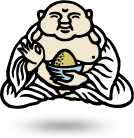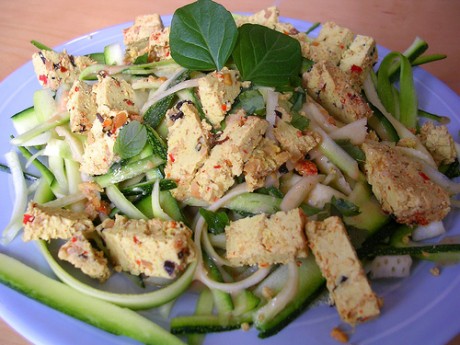The Theory Behind Eating Raw
Posted by Guest on Tuesday, June 8th, 2010Tags for this Article: diet, health, raw food
Photo credit: Wockerjabby
The Foodists Guest Contributor column will regularly feature content from travelling Foodists, subject matter experts and people we generally like. Today Lauren Mote, award winning mixologist at he Refinery dishes on the theory behind following a raw diet. Enjoy.
~Degan Beley, Editor.
Over the last several weeks my boyfriend and I have been eating a “raw” or mostly uncooked diet. After being severely ridiculed by friends and family for a random choice in diet change, I can now explain why it’s great, and why I will continue to incorporate these eating principles into my daily life going forward. But don’t be fooled, I fell of the raw-wagon a few times, and it wasn’t so bad – I think it’s important to treat this diet change as an “inclusion of basic practices” that make you feel good – the use of “cheat days” is also unnecessary – you want a burger? Eat the damn burger. It won’t kill you, it’ll just help you love your raw life more, and savour the decadent things… eating slower…. mmmmmm… We’ll chalk this story up to a “summary of awesomeness”, and soon you too will high-five yourself, reach around and pat yourself on the back when you grab a branch of organic broccoli to snack on instead of a bowl of skittles. Taste the new rainbow.
Theory: “Dining in the Raw” by Rita Romano (published 1992) is a bit of a bible. Not just because it has super random recipes so you can stuff yourself with something other than raw kale (which I might add is painful at the same time everyday…), but because it thoroughly explains the macrobiotic properties of the edible world and what that means for us – here, in laymans terms: can I eat that raw squash or is it a tad weird? Will my intestine’s explode? As I certainly not an expert on raw dining, what I do know is that I am an expert-eater in general. My body talks a lot – tells me exactly what it wants, and when. I am high-energy person that requires food and beverage every 2 hours at least. I also know that my body and blood thrive on vegetables, fruit, grains and meat. I also know and understand that my body stabs me in the ribs with an imaginary ice-pick when I choose to eat, and attempt to digest a medium rare steak over a bowl of raw beef tartare. The most important “tangible” theory that Rita lends is this: Living, sprouted and “raw” foods contain more enzymes that aid in effective digestion than anything else on the planet. These enzymes are lost in cooking, or the boiling water they’re slightly blanched in. Although Rita suggests that meat is hard to digest whether raw or cooked, THIS DIET CHANGE IS NOT ABOUT BECOMING A VEGAN. In fact, it’s about digestion, and the body’s longevity. The more raw you eat, the better your skin, and the better your body.
Eating: Jonathan and I have been rather busy preparing food for ourselves. Since we only picked up “Dining in the Raw” a week ago, we were traveling on the good-graces of our vegan-chef-friend Jeremy, and the advice from his partner, Lindsay (also a chef, but 100% raw vegan). I will say that spending 3 days a week in the Organic Acres vegetable market at Granville Island has been as nourishing as it’s been expensive – collecting as much as possible in produce without the sense of “over-buying, or over-eating” but being able to sustain the produce over 2-3 days has been challenging. It’s no secret that preparing raw food is difficult if you have no clue what “raw” means to you above and beyond a bag of slimy peeled baby carrot sticks and a peeled orange. It should also be mentioned that “raw” is not for everyone, but then again, neither is Tim Horton’s coffee. We made some exceptions to the raw movement – we thought it quite important to retrieve a sustainable amount of fat through 8% Mediterranean style yogurt with quinoa, and Odwala Green Goodness smoothies in the morning to enhance our brains. I started to feel around 2:00pm everyday that my brain was going to explode – minor headaches, muscle pain, and lack of focus – this is when cooked rice becomes a necessity for Lauren.
Now that it’s the better part of 6 weeks that I have been eating “raw”, my body has adapted. Its adapted to the point where cooked food actually affects my digestive system – what I mean by that is the almost instant distention of my stomach – this is attributed to my intestinal enzymes working overtime without the introduction of new ones that we spoke about a few lines back. The amount of discomfort I can now associate with cooked beef is unfortunate, but my body thanks me for the good-bye. My skin is radiant, my organs clean, and my body is super strong. I feel like I have gone through a body transformation, kinda like Spider-Man, except without the dirty spiders nibbling at my hand-skin. I haven’t tried to climb my apartments’ external walls yet, but I suspect eating elevated amounts of broccoli will not make my hands and feet stick, in fact I’ll likely be perceived as the psycho on floor 12 base jumping down to London Drugs without success…
Creating items and meals that incorporate those “meaty” textural and visual components – grain and seed burgers with bulgur wheat and red quinoa (the same mixture used for “falafel” the next day), tofu, mushrooms, and Jonathan’s most recent culinary invention, eggplant BBQ sauce – helps ween me off those uncomfortable feelings of being an enzymatic punching bag. It’s amazing when the only meats available to me in Gastown at Nester’s Market are garbage from the states. It makes the decision so much easier to make. When I have real trouble is at Granville Island at the Fish Market, and Whole Foods where those delicious kushi and kumamoto osyters, honey mussels, Cornish hens, ducks and ribeye steaks stare me in the face tempting me with their imminent flavour. At those times, I fight for seafood, and go home. This is not a moral issue, just a digestive issue. It’s in the interest of keeping things “consistent” that I make these choices, however there’s something so Neanderthal about eating raw meat that is both satisfying and odd. I guess like anything we eventually return to a simplistic beginning, only this time I’m armed with a super hi-fi food processor.
Discoveries:
1) I went to Whole Foods to buy nuts. I spent $90. Eating raw is expensive. If you cannot afford it, don’t do it. You MUST eat constantly. Accidentally starving yourself will cause your body to eat away at muscle mass for energy. What good is it if you’re thin, and radiant, but can’t lift your scrawny body off the couch? Gross.
2) Get a bike. Cycle everywhere. Afterward, give your body what it craves, regardless. I crave greens and hard boiled eggs, don’t know why, but I don’t argue. The eggs are allowed as the temperature doesn’t reach over 115C (which I might add is the rule for raw diets).
3) Eating raw with a partner – either friend or lover – is the easiest. Split groceries, eating out, and prepping for the week.
4) Make things in advance – ferment cabbage and other shredded roots with salt and water in a cool dry place covered in plastic wrap for 3 weeks. Bulgur wheat and quinoa when cooked and cooled taste great on yogurt, plus create binder and “filler” for burgers and salads. Example: the best kimchi I’ve ever had, made using wild ramps (leeks) courtesy of Jonathan.
5) Be creative. You cannot hurt yourself while eating raw, so experiment. Think about texture comparisons from raw to cooked to create interesting substitutes. Use books and nutritional information about grains, herbs, plants, legumes, flowers, nuts, etc… to learn the best way to use them and how much to eat.
Resources:
Living Raw Food – Sarma Melngailis
Dining in the Raw – Rita Romano
On Food and Cooking: The Science and Lore of the Kitchen – Harold Magee
Molecular Gastronomy – Herve This



Posted on June 16th, 2010
Campbell says:
Hey, enjoyed this article. Very interesting.
I was surprised about the cooked eggs. It seemed like 115 C was a bit warm for raw (it would allow anything to be boiled). I checked wikipedia on raw eating and saw this:
“Raw foodism can include any diet of primarily unheated food, or food warmed to a temperature less than 40 °C (104 °F) to 46 °C (115 °F). ”
So I think boiling things are not part of the raw world.
CM